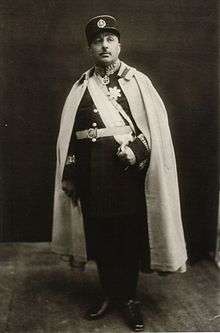Ghassem Khan Vali, Sardar Homayoun
| Ghassem Khan Vali, Sardar Homayoun | |
|---|---|
 | |
| Born |
1874 Tehran |
| Died |
1933 Tabriz |
| Occupation | General Army, Politician, First Mayor of Tabriz |
Ghassem Khan Vali (1878–1933; Persian: سردار همايون والی قاسم), otherwise and better known by his military title of Sardar Homayoun, the son of Ali Khan Vali and grandson of Mohamad Ghassem Khan Vali,[1] was the first Imperial Iranian Army general to graduate from the prestigious Saint-Cyr Military School in France, which was founded by Napoléon in 1802. During the Overthrow of the Qajar dynasty, Sardar Homayoun was encouraged by the local politicians and moderates, backed by Edmund Ironside, 1st Baron Ironside and the British Government, to become the Shah of Persia (the fact that his lineage could be traced to the Qajar dynasty gave added incentive to have him on the throne ). He mainly declined out of his loyalty to Ahmad Shah, although it was stated that it was out of his fear for his family's safety and his moral reluctance to use force against his countrymen, a measure which was inevitable for the maintenance of the monarchy. His reluctance was seen as cowardice by the British, and so the position was later given to Reza Shah Pahlavi.
During Reza Shah's reign, he was appointed commander of the Cossack Division in Northern Iran.
He retired soon after to his family's estate to pursue writing and farming. An aristocrat by birth, he believed in the character conferred by military education and discipline. His cousin, Doust Mohammad Khan Moayer ol-Mamalek, was the son-in-law of Nasser al-Din Shah who married her daughter Princess Esmat os-Saltaneh.
He had five daughters and two sons. His sons, Ebrahim and Ali Vali, also served in the Imperial Iranian Army as army generals during the reign of Mohammad Reza Shah.
He was the first Mayor of Tabriz in 1908, (see list of Tabriz Mayors), and as a modern man, he was at the origin of the first electrical generator to Tabriz. He also introduced the first metallic printing press in Iran. Sardar Homayoun also was one of the first modern economists in Iran.
-

Sardar Homayoun dans sa propriété de Sa'dâbâd
-

Sardar Homayoun dans sa propriété de Sa'dâbâd
-

Sardar Homayoun dans sa propriété de Sa'dâbâd
-

Sardar Homayoun dans sa propriété de Sa'dâbâd
-

Sardar Homayoun au volant
-

Première usine de production d'électricité à Tabriz
-

The first tramway in Tabriz
References
- Black Coup
- Iran and the Rise of Reza Shah: From Qajar Collapse to Pahlavi Power - by Cyrus Ghani - p.140
- The Zarrinkafsch (Bahman-Qajar) Family